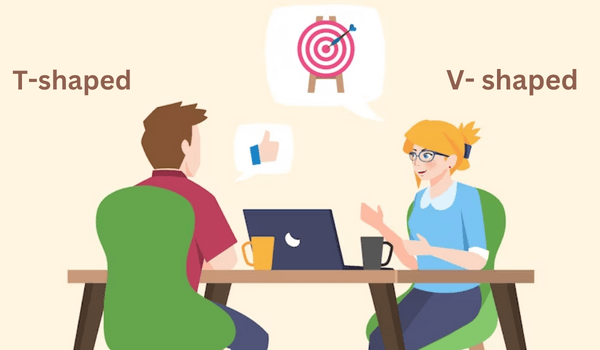Does the shape of an employee matter? It sure does. No, we don’t mean the physical shape of employees here. We are referring to the skills and abilities of the employees.
In the world of employment, two terms are often used to describe the skills and capabilities of employees —‘T-shaped’ and ‘V-shaped’ employees.
These shapes refer to the width and depth of the employees’ skill set and can be used to assess their potential to succeed in their current role, as well as their ability to take on new challenges and advance in their career.
As a management consultant, David Guest was the one who first introduced the concept of T-shaped employees in the 1990s. A T-shaped employee has a broad range of knowledge and skills across different areas, represented by the horizontal bar of the alphabet ‘T’. Such a person also has deep expertise in one or two areas, represented by the vertical bar of the alphabet.
“The debate between V-shaped and T-shaped employees is not a black-and-white issue. Both have their advantages depending on the industry sector and time horizon we are operating in.”
Ravi Mishra, Sr VP-HR, advanced materials business, Aditya Birla Group
T-shaped employees are often seen as generalists with a specific area of expertise, which makes them highly adaptable and versatile in a range of roles.
On the other hand, V-shaped employees are those who have immense expertise in a single area, but lack the breadth of skills and knowledge that T-shaped employees possess. The shape of the V represents the employee’s specialised skills and knowledge, but the lack of breadth in their skills means they may struggle to adapt to new challenges or work outside their area of expertise.
T-shaped vs V-shaped employees — Who has more potential?
The answer to this question is not straightforward, as both types of employees have their own strengths and weaknesses.
T-shaped employees: With their broad range of skills and deep expertise in one or two areas, T-shaped employees are highly adaptable and able to take on a range of tasks and responsibilities. They are often seen as valuable team members who can collaborate effectively with colleagues from different departments or with varying skill sets. Their broad range of knowledge also means they are more likely to come up with innovative solutions to complex problems.
Talking about the potential challenges of working with both T- and V-shaped employees, one of the main challenges will be to encourage employees to acknowledge the current realities and support them in acquiring new skills instead of dwelling on past accomplishments.
A Thiru, a C-suite HR professional
Ravi Mishra, Sr VP-HR, advanced materials business, Aditya Birla Group, says the debate between V-shaped and T-shaped employees is not a black-and-white issue. Both have their advantages depending on the industry sector and time horizon we are operating in.
In today’s world, however, where collaboration and innovation are critical, T-shaped employees have become increasingly valuable. The ability to collaborate effectively with different teams has become an essential skill for all employees today, especially leaders.
“T-shaped employees possesses a broad range of skills and knowledge that allows them to collaborate effectively across different domains and work with teams from different disciplines. This collaborative approach fosters innovation and creativity, by bringing together different perspectives and expertise,” opines Mishra.
However, there is a downside too. T-shaped employees may struggle to keep up with the latest developments and trends in their areas of expertise. Their deep knowledge may also make them less likely to take risks and try new approaches.
V-shaped employees: With their deep expertise in a single area, V-shaped employees are often seen as subject matter experts. Therefore, they are highly valued for their specific knowledge and skills. They are often the ‘go-to’ people for colleagues when they need advice or guidance on a particular issue.
V-shaped employees are also highly motivated to keep up with the latest developments in their area of expertise and are more likely to take risks and try new approaches.
Mishra adds that the advantage of V-shaped employees lies in industries that require a deep understanding of a particular domain, such as research and development (R&D) in a technology company.
“In such industries, it is essential to have experts who can solve complex problems and create innovative solutions. V-shaped employees possess a high level of specialised knowledge and can apply their expertise to their work, resulting in more efficient and effective outcomes,” says Mishra.
The downside of being V-shaped employees is that sometimes they may struggle to work effectively with colleagues from different departments or with different skill sets.
Talking about the potential challenges of working with both T- and V-shaped employees, A Thiru, a C-suite HR professional, says that one of the main challenges will be to encourage employees to acknowledge the current realities and support them in acquiring new skills instead of dwelling on past accomplishments.
“Implementing job rotation, role changes and cross-functional exposure at regular intervals that align with employees’ strengths and the organisation’s needs, regardless of work levels, can result in a mutually-beneficial outcome for all parties involved, including the end customer. This approach can lead to increased value for the customer while also benefiting both the employee and the organisation,” says Thiru.
However, Thiru says that one should not measure employee potential based on a broader classification such as T or V, as each individual is unique and incidentally falls into ‘T’ or ‘V’ category at a given point of time.
He suggests, “As futuristic HR leaders, we must design processes that encourage the rotation of high-potential employees in ‘T’ and ‘V’ shapes and encourage expertise-led teams instead of organisational bureaucracy. This will help employees evolve their career-development plan on their own, in sync with their interests.”
Ultimately, the key to success at the workplace is not just having a particular set of skills but being able to use them effectively in a variety of situations and continuing to develop new skills as the world of work evolves.






2 Comments
While there are pros and cons of both the types ,many industries will also require people with hybrid mix of both the types, wherein their skills as one type will be required on certain tasks and the other on some other type. HR should in fact try to develop this hybrid talent pool in their organisations.
Nice article . Every prefers an all-rounder ie a hybrid model . However, it’s very rare to find such examples and could be like trying to find a needle in a haystack . Ideally such high performing employees need to go through a professional Executive coaching by opening their mindset’s . Self awareness and critical thinking skill enhancement are some of the methods